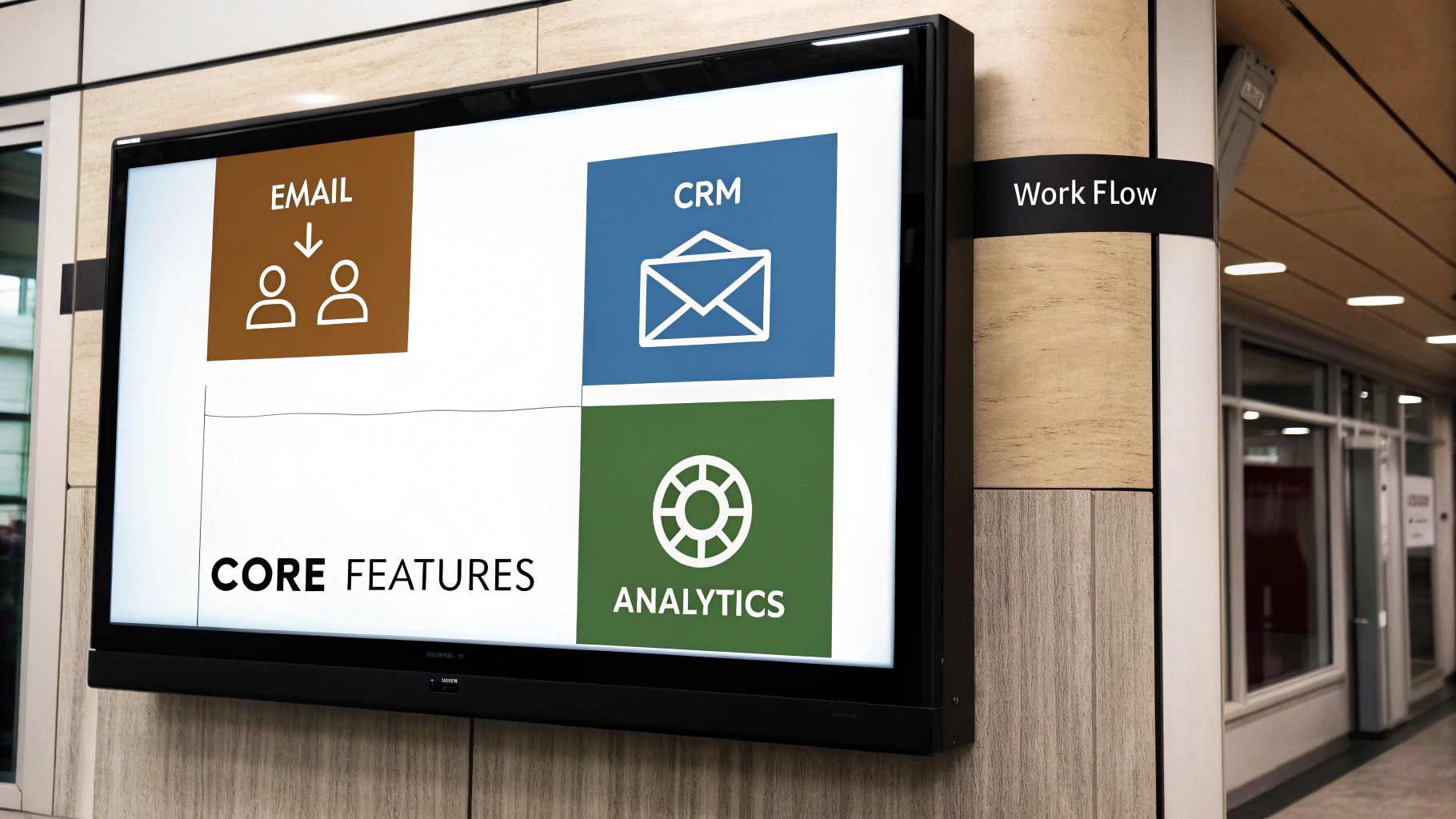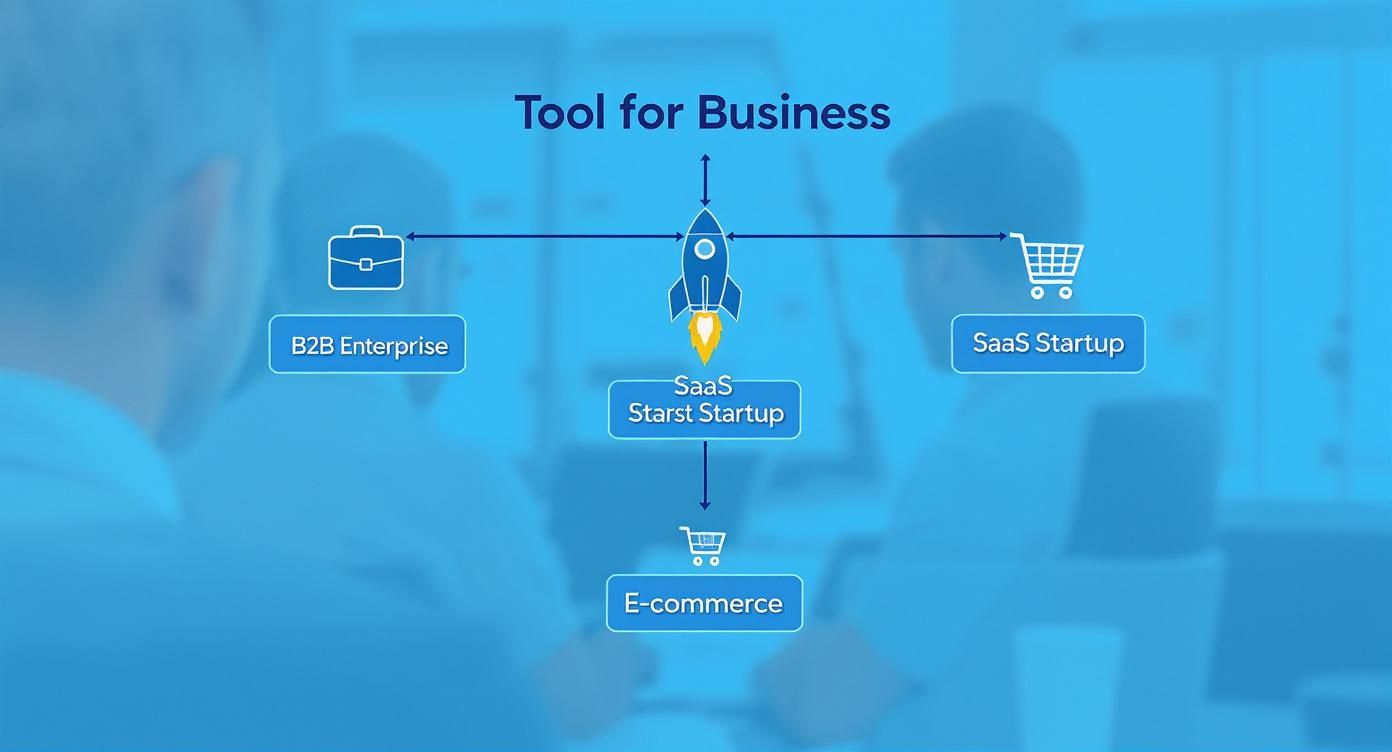Marketing Automation Tools Comparison Guide
Picking the right marketing automation platform is a huge decision for any business. The choice often boils down to one fundamental question: do you want an all-in-one platform like HubSpot that keeps everything under one roof, or a super-flexible tool like Make.com that lets you build a custom tech stack? There's no single right answer—it all depends on whether you value a unified system or total adaptability.
How to Choose Your Marketing Automation Platform
Choosing marketing automation software isn't just about ticking off features on a list; you're essentially picking a strategic partner for growth. The right platform can finally solve those nagging problems, like inconsistent lead nurturing or the struggle to prove marketing ROI. But get it wrong, and you're stuck with data silos and a clunky workflow that slows everyone down.
This guide is designed to give you a clear framework for making a smart choice in a very crowded market. A good place to start your research is by checking out lists of the top AI marketing tools to get a feel for the major players.
Core Evaluation Criteria
It’s easy to get lost in the weeds comparing every little feature. Instead, let's zero in on four practical criteria that really determine if a platform is the right fit for your company.
- Scalability: How well does the tool grow with you? You need to know how pricing and features will adjust as your contact list gets bigger, your team expands, and your campaigns get more complex.
- True Cost of Ownership: Don't just look at the monthly price tag. Make sure to factor in the hidden costs, like mandatory onboarding fees, specialized training for your team, and any premium third-party apps you'll need.
- Integration Depth: A platform's real power comes from how well it talks to your other systems, especially your CRM and data warehouses. The deeper the integration, the smoother your workflows will be.
- Ideal Use Case: Every platform has a sweet spot—a scenario where it truly shines. Understanding this is the key to finding a perfect match for how your business operates.
To get us started, here’s a quick look at the platforms we'll be comparing.
| Platform | Best For | Key Differentiator | Common Pricing Model |
|---|---|---|---|
| HubSpot | Businesses needing an all-in-one solution | Integrated CRM and ease of use | Contact-Based Tiers |
| ActiveCampaign | SMBs focused on advanced automation | Powerful and flexible workflow builder | Contact-Based Tiers |
| Marketo | B2B enterprises with complex sales cycles | Advanced lead lifecycle management | Feature-Gating |
| Make.com | Teams needing custom, flexible solutions | Visual, no-code workflow creation | Operation-Based |

The marketing automation market is exploding for a reason. It was valued at USD 6.65 billion in 2024 and is expected to climb to USD 15.58 billion by 2030. This incredible growth just shows how much businesses are relying on these tools to work smarter and make data-backed decisions.
A common mistake is choosing a platform based on its popularity rather than its strategic fit. An enterprise-level tool can overwhelm a small team, while a simple tool can bottleneck a growing company. The goal is alignment, not just adoption.
Ultimately, making the right call comes down to understanding the core marketing automation best practices and figuring out how they apply to your specific goals. This comparison will give you the clarity you need to do just that.
Getting a Lay of the Land in Automation Software
Before you can pick the right marketing automation tool, you have to know what you're walking into. The market isn't just a jumble of software; it's a living ecosystem. It's shaped by major trends, what users are clamoring for, and a few big names that call the shots. Getting a feel for these dynamics is the first step in making a smart choice.
Right now, two big things are steering the ship. First is the drive for intensely personal marketing, fueled by AI and predictive analytics. Second, there's a huge wave of demand for no-code platforms, letting marketers build sophisticated workflows without ever touching code. This is a game-changer, putting serious power into the hands of a much wider audience.
Why Market Share and Ecosystems Matter More Than You Think
A platform's market share isn't just a number to brag about—it has a real impact on how successful you'll be with it. The more people using a platform, the better its app marketplace, community support, and the pool of available talent will be. It's a classic network effect.
Think about it: a platform with a massive user base will have thousands of third-party apps designed to plug right in. This makes connecting to your existing tools, from CRMs to e-commerce platforms, a breeze.
A tool's popularity directly translates into a stronger support system. When you go with a market leader, you're not just buying a piece of software. You're plugging into a massive community of users, developers, and certified experts who can help you troubleshoot and get creative.
On the other hand, a smaller, niche tool might have a killer feature you love, but you could find yourself stuck when it comes to integrations or finding a freelancer who knows it. This context is crucial when you're thinking about the long-term health of your marketing stack.
Who's on Top and Who's Coming Up Fast
The market share numbers tell a story about who has the most sway. HubSpot is currently the big fish, holding about 29.36% of the marketing automation pond. It's followed by heavy hitters like Oracle Marketing Cloud at 5.91% and Adobe Experience Cloud at 5.46%.
For years, big enterprise companies have run the show, making up around 62.5% of the market in 2024. But the real story is the explosive growth among smaller companies. Small and medium-sized businesses (SMEs) are the fastest-growing group, expanding at a projected 15.2% CAGR through 2030. This isn't just a small shift; it's a complete democratization of the technology. For a deeper dive, it's worth checking out the latest marketing automation statistics.
This change in the market has huge implications for your choice. The old-guard enterprise platforms were built for huge, technical teams with bottomless budgets. But the rise of the SME has opened the door for a new breed of nimbler, more intuitive, and wallet-friendly tools.
This is exactly where platforms like ActiveCampaign and flexible integrators like Make.com shine. They're built for businesses that want all the automation power without the enterprise-grade headaches and price tag. They are designed to be a piece of a custom-built tech stack, letting you pick the best tool for each specific job instead of getting locked into one vendor’s world. That flexibility is a massive advantage when you stack them up against the all-in-one giants.
A Deep Dive Into Core Platform Features
Picking a marketing automation platform is a bit like choosing a car. Some are like all-in-one SUVs, built for comfort and ease of use, while others are high-performance race cars, fine-tuned for a specific, powerful purpose. To make the right call in this marketing automation tools comparison, we need to pop the hood and see what’s really driving these machines.
This section gets past the shiny brochures and into a detailed, side-by-side analysis of what these platforms actually do. We'll frame this comparison around the four pillars that hold up any great marketing automation strategy.
- Email & Workflow Automation: This is the engine room. It’s where you build the customer journeys that turn leads into loyal fans.
- Lead Management & Scoring: Think of this as the system's brain. It identifies, prioritizes, and routes your most promising prospects.
- CRM & System Integration: This is the central nervous system, connecting your marketing data to sales, support, and the rest of your business.
- Analytics & Performance Reporting: This is your command center dashboard, showing you what’s working, what isn't, and how to prove your marketing ROI.
By looking at how HubSpot, ActiveCampaign, Marketo, and Make.com handle these four areas, you’ll get a much clearer picture of which one fits your team’s style and goals.
Email and Workflow Automation
At the end of the day, marketing automation is all about sending the right message to the right person at the right time. The email builders and workflow engines are the tools that make this happen, and each platform has its own philosophy.
HubSpot is famous for its simplicity and tight integration. Its visual workflow builder is incredibly intuitive, making it a breeze for marketers who aren't super technical to create powerful sequences based on email opens, page views, or form submissions. The real magic, though, is how seamlessly it connects to the HubSpot CRM. Every single action is logged on a contact's timeline, giving both marketing and sales a crystal-clear history.
ActiveCampaign, on the other hand, is all about flexibility and raw power. Its automation builder is a dream for detail-oriented marketers, offering deep control with conditional "if/then" logic, split actions, and goal tracking. You can build incredibly specific journeys, like sending a follow-up only if a contact visited the pricing page three times but hasn't opened your last two emails. For a closer look at building these kinds of sophisticated sequences, you can find great strategies for creating automated email marketing campaigns.
Key Differentiator: While HubSpot nails user-friendly, CRM-centric automation, ActiveCampaign gives you a much more powerful, logic-driven canvas for building highly customized and complex user journeys.
Marketo is built for the enterprise, and its focus is on scale and lifecycle management. Its automation tools are designed to handle millions of contacts and navigate the long, winding sales funnels common in B2B. It’s less about a flashy interface and more about rock-solid, reliable execution of complex, multi-stage campaigns that can span months or even years.
Make.com operates on a completely different level. It isn't an email marketing platform itself but a universal workflow integrator. You can use it to connect your favorite email service (like Mailchimp or Brevo) to hundreds of other apps. This modular approach lets you build hyper-custom "if this, then that" scenarios that no single platform could manage on its own, like triggering an email campaign the moment a specific cell in a Google Sheet is updated.
Here's a quick look at how their core features stack up.
Core Feature Comparison of Leading Automation Tools
This table breaks down how each platform approaches the essential functions of marketing automation, from building campaigns to managing customer data. It provides a quick, scannable overview to help you see the key differences at a glance.
| Feature Category | HubSpot | ActiveCampaign | Marketo | Make.com |
|---|---|---|---|---|
| Workflow Builder | Highly visual, user-friendly, and fully integrated with its native CRM. | Extremely flexible with advanced logic, goals, and split testing options. | Robust and scalable, designed for complex, multi-stage B2B lifecycles. | Not a native builder; acts as a universal connector between apps. |
| Lead Scoring | Simple and effective, built directly into the CRM for a unified view. | Dynamic and automation-driven, allowing scores to trigger actions in real-time. | Enterprise-grade, with a focus on modeling the entire revenue cycle. | N/A – Relies on data from connected apps to trigger scoring actions elsewhere. |
| CRM Integration | Best-in-class native CRM; the entire platform is built around it. | Offers a solid SMB CRM and deep integrations with major platforms like Salesforce. | Designed for deep, two-way sync with enterprise CRMs (Salesforce, Dynamics). | The ultimate integrator; connects virtually any marketing tool to any CRM. |
| Email Marketing | Includes a full suite of email marketing tools with templates and A/B testing. | Powerful email features with advanced segmentation and personalization. | Comprehensive email platform built for large-scale, enterprise-level sending. | Connects to any email provider, enhancing them with cross-app automation. |
As you can see, the choice isn't about which tool is "best," but which tool's approach best fits your specific needs for control, integration, and scale.
Lead Management and Scoring
Not every lead is ready to buy. A huge part of marketing automation is figuring out which prospects are hot and which ones need more time, then making sure your sales team knows the difference.
HubSpot’s lead scoring is baked right into its CRM, which makes it super accessible. You can add or subtract points based on demographics (like job title) and behaviors (like downloading an ebook). This integrated system gives you a single, unified view of a lead's journey.

This screenshot shows how HubSpot thinks about the entire marketing funnel as one continuous experience, from attracting visitors to delighting customers. The takeaway is their focus on a single, cohesive system where lead management is just one piece of a much larger puzzle.
ActiveCampaign also has powerful lead scoring, but it’s geared more toward automation triggers. A lead's score can change on the fly based on their engagement, instantly pushing them into a different automation sequence. This is perfect for businesses with faster sales cycles that need to jump on buying signals the moment they appear.
Marketo elevates lead management to the enterprise level with its Revenue Cycle Modeler. This is way more than just lead scoring; it’s a complete framework for defining every single stage of the customer lifecycle, from an anonymous website visitor to a brand advocate. It’s built for the complexities of B2B sales, where tracking a lead's progress requires deep alignment between marketing and sales.
CRM and System Integration
Your marketing automation platform is useless if it’s an island. It has to talk to your CRM and other business-critical tools to create a single, reliable source of customer data.
This is where HubSpot really shines. Its native, fully integrated CRM is the sun in its solar system; everything else revolves around it. Marketing, sales, and customer service data all live in one place, which completely eliminates the data-syncing headaches that drive so many teams crazy. If you want an all-in-one platform, this is a massive plus.
ActiveCampaign offers its own built-in CRM, but it's geared more toward small and mid-sized businesses. Its real ace in the hole is its deep integration library. It connects smoothly with hundreds of third-party apps, including major CRMs like Salesforce, letting you pair its best-in-class automation engine with your existing sales platform.
Marketo, being an Adobe product, is built to integrate flawlessly with other enterprise giants like Salesforce and Microsoft Dynamics. These integrations are heavy-duty, designed for two-way data synchronization at a massive scale to keep marketing activities and sales outcomes in perfect lockstep.
And then there's Make.com. True to form, it’s the ultimate integration tool. It’s the connective tissue for your entire tech stack. You can build visual workflows that pass data between your marketing platform, CRM, project management software, and even your accounting tools—all without writing a single line of code. This gives you unlimited freedom if you prefer a "best-of-breed" tech stack over an all-in-one suite.
Comparing Pricing and Total Cost of Ownership

The sticker price you see on a marketing automation platform’s website is rarely the full picture. It's just the tip of the iceberg. To make a smart investment, you need to dig deeper and look at the total cost of ownership (TCO). This means factoring in all the hidden and ongoing expenses that can quietly inflate your budget over the years.
Your first step is getting a handle on the platform's pricing model. Every tool has a different philosophy for billing, and each one scales in a way that can either supercharge your growth or put a ceiling on it.
Deconstructing Common Pricing Models
Most pricing plans fall into one of three buckets: you pay based on contacts, features, or consumption. Each one has major implications for your budget down the road.
- Contact-Based Tiers (HubSpot, ActiveCampaign): This is the most common model out there. Your monthly bill is tied directly to the number of contacts in your database. It seems simple at first, but costs can jump surprisingly fast as your email list grows. In a way, it can penalize you for successful lead generation.
- Feature-Gating (Marketo): This is the go-to model for enterprise-level tools. You pay for access to specific sets of features, with higher tiers unlocking advanced capabilities like predictive analytics. This model isn't as sensitive to your contact count, but it usually requires a much bigger upfront investment.
- Operation-Based Consumption (Make.com): A newer, more direct model where cost is tied to usage. You're paying for the number of "operations" or tasks your automations actually perform. This approach gives you incredible predictability and ensures you're only paying for the value you're actually getting.
A HubSpot plan that looks like a great deal with 1,000 contacts can become a major budget item once you hit 10,000. On the flip side, a tool like Make.com lets your costs scale predictably with your activity, not just the size of your audience.
A critical mistake is budgeting only for the monthly subscription. True TCO includes mandatory onboarding fees, specialized training, premium third-party app connectors, and the internal staff time required to manage the platform effectively.
Uncovering the Hidden Costs
Beyond that monthly fee, several other expenses can blindside you. If you don't account for them from the start, you'll find a huge gap between what you expected to spend and what you actually pay.
Understanding the ROI of marketing automation is a crucial piece of this puzzle, as it helps justify these often-overlooked but necessary costs.
- Mandatory Onboarding Fees: Many enterprise platforms, particularly in the Marketo and HubSpot ecosystems, require a one-time onboarding fee that can run into thousands of dollars. It’s often non-negotiable and covers your initial setup and training.
- Specialized Training and Certification: To really master a complex platform, your team might need ongoing training or official certifications. These programs are an investment in your team's skills, and they're rarely free.
- Premium Integrations: Platforms love to boast about their huge app marketplaces, but many of the most useful connectors come with their own price tag. If you need to link up with a specialized e-commerce platform or data warehouse, you'll often need a separate subscription to a third-party service.
Let's look at how these costs play out in the real world.
TCO Scenario: A Startup vs. An Enterprise
Picture a fast-growing startup. They might go with ActiveCampaign for its powerful automation features at a reasonable starting price. But as their contact list balloons from 2,000 to 20,000, their monthly bill could easily increase fivefold. They might also discover they need a premium connector to sync data with their custom CRM, adding another monthly fee to the pile.
Now, think about a large enterprise choosing Marketo. Their initial investment is massive, including a high annual license fee and a hefty onboarding package. The upside? Their cost stays relatively flat even as they add hundreds of thousands of contacts because their pricing is tied to features, not database size.
This highlights the fundamental trade-off. Pay-as-you-grow models have a low initial risk but can get expensive at scale. Enterprise models demand a huge upfront commitment but offer more predictable costs in the long run.
Matching the Right Tool to Your Business Needs
A long list of features tells you what a tool can do, but it doesn't help you figure out if it's the right one for your business. The best marketing automation platform isn't the one with the most bells and whistles; it’s the one that clicks with your team’s workflow, budget, and where you want to go next. This is where we move from a theoretical comparison to what actually works in the real world.
Let's walk through three common business scenarios. Each has its own goals, day-to-day challenges, and resource limits. Seeing how different platforms fit—or don't—in these situations will help you see your own business in one of them.
The B2B Enterprise with a Complex Sales Cycle
Picture a large B2B tech company selling high-value software. Their sales cycle is a marathon, not a sprint—often lasting six to nine months and needing buy-in from multiple people, from IT managers all the way up to the C-suite. The big challenge is keeping leads warm over that long haul, tracking every interaction, and making sure the handoff from marketing to a big sales team on Salesforce is seamless.
For this kind of company, Marketo is the undisputed champion.
Marketo's entire system is purpose-built for the tough realities of the B2B lead lifecycle. Its real power is in letting you build deep, multi-stage nurturing campaigns that can intelligently change course based on a lead's behavior or engagement score. It's also a beast at tracking account-based marketing (ABM) campaigns, giving you a clear view of which contacts at a target company are actually paying attention.
Marketo's killer feature is its deep, native sync with enterprise CRMs like Salesforce. It ensures marketing efforts and sales outcomes are perfectly aligned, giving leadership a true, end-to-end view of the revenue funnel.
Sure, a tool like HubSpot could get you part of the way there, but Marketo's fine-tuned control and enterprise-level scalability are just what this environment needs. The higher price tag and steeper learning curve are a fair trade for the power to manage a complex, high-value sales pipeline.
The Scrappy SaaS Startup
Now, let's switch gears to a SaaS startup that just landed its seed funding. The team is small, scrappy, and everyone wears multiple hats. Their immediate goals are all about speed: generate leads fast, convert free trial users to paid customers, and prove product-market fit—all without burning through their cash. They need a tool that’s easy to get running, flexible, and won’t have them sweating when their contact list starts to grow.
For this team, ActiveCampaign is a perfect match.
ActiveCampaign delivers an incredibly robust automation builder for a fraction of what the enterprise players charge. The startup’s marketing lead can jump in and quickly map out sophisticated "if/then" workflows for everything from onboarding trial users to sending targeted feature updates or winning back dormant accounts. It hits a sweet spot by combining email, automation, and a built-in CRM, offering a ton of value for a team on the rise.
- Powerful Automation: You can build complex customer journeys based on what users do in your app, how they engage with emails, or which pages they visit on your site.
- Cost-Effective Scaling: Its contact-based pricing is predictable and affordable, which is a huge relief for a startup watching its runway.
- Deep Integrations: It plays nicely with all the other tools a startup relies on, from Stripe for payments to Calendly for booking demos.
This is exactly the kind of scenario where an all-in-one giant like HubSpot could get expensive fast as the contact list balloons, while Marketo would be like using a sledgehammer to crack a nut. ActiveCampaign has the power, flexibility, and price point that a fast-moving startup needs. If you're running a small operation, you can find more tailored advice in this guide to the best marketing automation tools for small business.
The High-Volume E-commerce Store
Finally, imagine a direct-to-consumer e-commerce brand built on Shopify. They’re shipping hundreds of orders a day, and their marketing is all about driving repeat business and boosting average order value. Their biggest headaches are abandoned carts, segmenting customers by purchase history, and getting their marketing tools to talk to their inventory, shipping, and support systems.
This is where a flexible integrator like Make.com offers a unique competitive edge.
While most marketing platforms are focused on email, this store's needs go way beyond the inbox. They have to connect Shopify, their email platform (like Klaviyo), their shipping software, and their helpdesk (like Gorgias) into one cohesive, automated system. Make.com becomes the central nervous system that ties it all together.
For instance, they could build a workflow in Make.com that does this:
- It triggers the moment a customer with over five previous orders places a new one in Shopify.
- It then adds a "VIP" tag to their profile over in Klaviyo.
- Next, it pings a specific Slack channel, telling the fulfillment team to toss in a free gift.
- Finally, it creates a ticket in Gorgias to schedule a personal thank-you email from a support agent two days after the package is delivered.
You simply can't achieve this level of custom, cross-platform automation with a single, closed-off marketing suite. By using Make.com, the e-commerce store can create its own "best-of-breed" tech stack, picking the absolute best tool for each job and weaving them into a powerful, automated machine that actually moves the needle on revenue.
Making Your Final Decision with Confidence
Choosing the right marketing automation platform goes way beyond a simple feature-for-feature comparison. You need to look inward at your team, your budget, and where you're headed. The goal isn't to find the "best" tool on the market, but the best tool for your business.
To cut through the noise, let's recap what each platform really brings to the table. HubSpot is your all-in-one, integrated system—perfect for teams that value simplicity and a single source of truth. ActiveCampaign hits the sweet spot for growing businesses, offering sophisticated automation logic without the enterprise price tag. For complex B2B sales cycles, Marketo is the powerhouse, delivering unmatched lead management at scale. And then there's Make.com, the ultimate toolkit for building a completely custom tech stack from your favorite best-in-class apps.
Your Final Decision Checklist
Before you sign on the dotted line, get your team together and ask these honest questions. The answers will point you directly to the platform that fits like a glove.
- What’s our team’s tech-savviness? Are we looking for a simple, guided interface we can master quickly, or do we have the skills to handle a more technical, flexible environment?
- How does our budget work? Does a predictable, flat operational cost make more sense, or are we comfortable with a model that scales with our contact list?
- What are our integration deal-breakers? Is it more critical to have everything working seamlessly in one native system, or do we need the freedom to connect specialized, best-in-class tools?
- Where will we be in three years? Do we see our marketing getting more complex and requiring deep customization, or will our core needs likely stay the same?
This decision tree gives you a visual for how different businesses might tackle this choice.

As the graphic shows, a B2B enterprise is often going to gravitate toward deep CRM integration, while a nimble startup might prioritize flexibility above all else. E-commerce stores, on the other hand, frequently need robust, custom connections to function. Use this framework, and you’ll find a platform that doesn't just do a job—it becomes a genuine partner in your growth.
Frequently Asked Questions
Jumping into marketing automation always brings up a few questions. I've been in this space for a while, so here are some honest answers to the questions I hear most often when people are comparing their options.
Can I Switch Platforms Later If My Needs Change?
The short answer is yes, you can always switch. But it’s rarely a simple copy-paste job. Think of it less like moving houses and more like rebuilding your house on a new foundation.
You'll need a solid plan to export all your contacts, campaign assets, and historical data. Then comes the tricky part: importing everything into the new system and, most importantly, rebuilding all your automation logic from scratch.
The biggest challenge in migration isn't just moving the data; it's rebuilding the operational logic. Documenting your existing workflows, triggers, and segmentation rules before you even think about switching is the single most important step for a smooth transition.
How Much Technical Skill Is Required To Use These Tools?
This really depends on the tool you choose. They exist on a spectrum, and finding the right fit for your team's skillset is key.
- User-Friendly Platforms: Tools like HubSpot are built for marketers, not developers. Their drag-and-drop editors and clear interfaces mean you can get powerful campaigns running without ever touching a line of code.
- More Advanced Options: A platform like ActiveCampaign gives you more complex logic and deeper customization. You don't need to be a programmer, but a solid grasp of automation principles will help you unlock its true power.
- Highly Flexible Builders: Then you have tools like Make.com. While they use visual builders, creating truly custom solutions requires a good understanding of how APIs talk to each other and how to map data between different apps.
Do I Need A Dedicated Person To Manage Marketing Automation?
For a small business just starting out, a marketing generalist can absolutely handle the day-to-day, especially with a more intuitive platform.
But as you scale, you’ll hit a point where a dedicated marketing operations specialist or automation manager becomes a necessity. This person isn't just running campaigns; they're the architect of your entire marketing engine. They ensure the platform is optimized, build sophisticated workflows, keep your data clean, and tie every activity back to real business results. A dedicated manager is what turns a marketing tool into a genuine growth engine.
Ready to build an automation strategy that actually fits how your business works? MakeAutomation specializes in designing and implementing the specific workflows that cut out manual work and drive real growth. Get started with a free consultation today!







